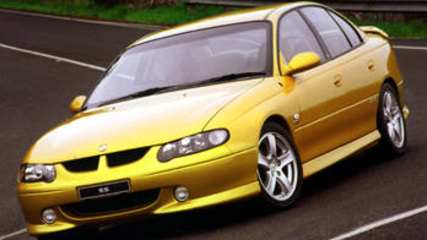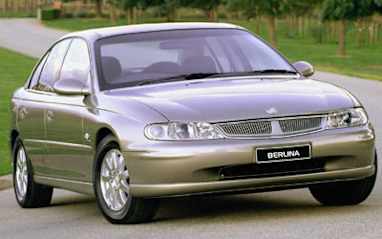Used Holden Commodore review: 2000-2002
By Graham Smith · 23 Jan 2009
When you’re on a good thing make it even better. That seemed to be Holden’s philosophy when it set about building on the success of the top-selling VT Commodore. The result was the VX, an even more refined and equipped update of the VT that continued Holden on its winning ways.The VT may seem like an overnight success, but it took nearly 10 years to happen. After a decade in which the Commodore was largely on the nose with car buyers for a variety of reasons Holden began the long road back in 1988 with the new generation VN. Progress was made with each model after the VN, but it was the VT that really broke through. The VX simply built on that success.Holden’s now retired chairman Peter Hanenberger summed up the VX perfectly when he said: “Our challenge was to take an extremely successful design and freshen it while retaining its huge appeal.”MODEL WATCH Although Holden’s styling boss Mike Simcoe is rightly proud of the new Monaro, he is even more proud of the VT Commodore that preceded the Monaro.The VT had a purity of style that is rare. Simply it looks good from all angles, and the body looks as if it’s been shrink wrapped over the wheels which gives it a strong, sporty on-road stance.When it came to the VX the changes were always going to be minimal. They had to be enough to distinguish it from its predecessor, but not radical enough to spoil its appeal. The major changes were to the headlamps, rear panel treatments, bumpers and colours.Changes under the skin were aimed at refining the VT package, with changes to the driveline, electronics, suspension and NVH that made the top-selling Holden smoother, more responsive, more economical and quieter.A new propshaft with dual rubber couplings addressed the drive line harshness that was a regular complaint from owners almost from the beginning. The new drive shaft significantly reduced driveline vibration and shudder on takeoff.There was a small gain in power from the 3.8-litre ECOTEC V6, up 5 kW to 152 kW at 5200 rpm, thanks to a new intake manifold that improved flow and volumetric efficiency. Fuel consumption was also up, between three and four per cent.The four-speed auto was recalibrated for improved response and softer downshifts, and there was a revised torque converter clutch for better drivability.The 171 kW supercharged V6 was unchanged, but was made available to Executive and Acclaim buyers.A higher flow intake manifold and revised fuel injectors helped boost the power of the 5.7-litre Gen III V8 5 kW to a new maximum of 225 kW.Meanwhile revisions were made to the suspension to soften the steering response, which had been judged too sharp on the VT. The aim was to induce understeer and the changes included raising the front lower control arm pivot, the stabiliser to strut link became a ball joint and the steering was recalibrated.Additional foam in the body pillars cut road noise travelling up the body while a raft of changes in the rear reduced airborne road noise.Safety was also enhanced through new body side structures that improved protection for the head, neck and chest in side crashes, identified as the major cause of serious injuries since the introduction of air bags reduced injuries sustained in frontal crashes.Further refinements were made to the VX in the Series II that hit the roads in 2001. Those changes mostly targeted the Commodore’s handling which was still thought to be too sharp even after the revisions made to the front suspension of the VX Series I.Where the front suspension was changed in the Series I, this time it was the rear-end’s turn to undergo surgery, adding a pair of extra links to the Commodore’s IRS to better control toe change. That meant more stability and predictability, which meant in real terms that the VX II was easier to place on the road and would maintain a set course more precisely.All models were fitted with an alarm, and there were new stalk controls for turn signals, wipers and cruise control. Berlinas now boasted twilight sentinel to turn headlamps on and off automatically.IN THE SHOP The Commodore’s V6 engine is pretty robust and gives little serious trouble. Look for oil leaks from the rear main seal and the front cover seal.The most contentious issue with the VX relates to the Gen III V8 and its oil consumption problem. Holden contends that the number of problem engines is relatively low, around two per cent of V8s sold, but it is of concern to anyone thinking of buying a V8.The good news is that not all engines are affected, it seems it is affected by the run in and the oil used during the run-in period, and the other good news is that the fix Holden released – new pistons with reduced piston to bore clearance – works. The fix was implemented in production with the release of VY, but was used before that on engines that needed rebuilding.Commodores up to and including VX Series I with IRS have a terrible habit of eating their rear tyres, but the introduction of the so-called ‘Control Link’ IRS with VX II pretty much solved that problem, which makes the Series II a better choice if you can afford the few extra bucks.Other than that the VX is relatively trouble free with no widespread serious problems.OWNERS’ VIEWS Wayne Brown owns a 2001 VX Series I S, with the supercharged V6 engine. It’s now done 61,000 km and Wayne says he’s generally happy with it, although he rates the service costs expensive. His main beef is with the trip computer, which doesn’t accurately show distance to empty, and the fuel consumption of the s/c engine when towing.Trevor Larkey has owned 38 cars over 40 years and with a couple of exceptions he rates the VX II the best car he’s ever owned. He waited until the VX II to solve the rear tyre wear problem and hoped the air-conditioning woes have been solved … so far so good. It has proved to be comfortable, economical and at less than $100 to service at the dealer it’s cheap in this area too. With 23,000 km on the clock the only problems so far have been boot catch adjustment, air leakage around the balance weights on the alloys and the Holden dealer persistently over-filling with oil at each service. He would recommend this model to anyone and with 2-3 years depreciation the VX II would be excellent buying.LOOK FOR • improved smoothness thanks mainly to new drive shaft• reduced road noise through more sound deadening material• slightly more power and lower fuel consumption from V6• check oil consumption of Gen III V8• more precise handling with new IRS in Series II• revised IRS also improves rear tyre wear problem that affected previous models.• good resale value







